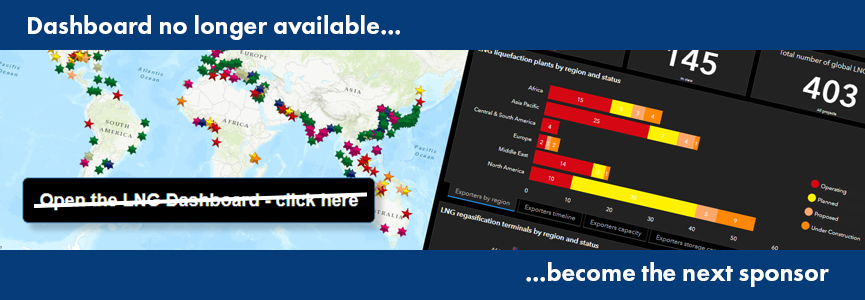The
Interactive LNG Dashboard is a comprehensive source of information on dedicated LNG
projects and LNG-related facilities. The web-based platform allows individuals to access the latest
project data, such as facility status and ownership details, as well as detailed explanations of processes
and other critical pieces of information.
The dashboard is no longer available but the extensive information is available through several Gulf Energy Information media platforms including
Petroleum Economist for incisive
commentary on the sector or
Global Energy Infrastructure for the detailed project data. Click on the respective media brands in the menu bar to visit and subscribe to these channels.
 Elevate Your Brand with World LNG Dashboard Sponsorship
Elevate Your Brand with World LNG Dashboard Sponsorship
Join the forefront of the global LNG industry and gain unparalleled visibility with World LNG Dashboard. Our comprehensive platform offers real-time data, market analysis, and industry news, making it the go-to resource for LNG professionals worldwide.
As a sponsor, you'll enjoy:
Prime Brand Exposure: Your logo and branding will be prominently displayed on our platform, reaching a targeted audience of industry leaders, decision-makers, and investors.
Customizable Branding Opportunities: Tailor your sponsorship package to align with your specific marketing goals.
Thought Leadership: Showcase your expertise through sponsored content, webinars, and articles.
Networking Opportunities: Connect with key industry players and potential partners at exclusive events.
Don't miss this chance to:
Enhance your brand reputation as a leader in the LNG industry.
Drive customer acquisition and increase market share.
Build valuable relationships with key stakeholders.
Contact us today to learn more about our sponsorship packages and how they can benefit your business.
For further information or to request you own
Petroleum Economist print or digital mapping solutions please contact:
John Royall
Interim CEO - Petroleum Economist
john.royall@gulfenergyinfo.com
+1 (713) 520-4443
The
World LNG Dashboard is produced by
PE Maps in association with,
Petroleum Economist and
Global Energy Infrastructure
Petroleum Economist is a global digital-only channel of interest to leaders in the oil and gas sector as well as all stakeholders involved
in the burgeoning LNG economy. The readership is drawn from operators, engineering and services, government, finance, consultancies,
law firms and academia—with a firm bias towards the C-suite, senior management and partner level.
Project data and market intelligence is consolidated in the
GEI website for easy access. GEI carries project data
and the latest news for refining, petrochemicals, LNG, oil and gas pipelines, renewables, and hydrogen. All data covers the global marketplace.
All data is updated on a continuous basis, and includes status, scope, project description, and other essential data. GEI data is used by the world’s
largest energy companies and suppliers to track projects around the world. Used by both business development and market analysts, a comprehensive view
and intelligence of the global energy market gives users an advantage in winning new business and understanding trends in important market segments.


 Petroleum Economist Interactive Dashboard
Petroleum Economist Interactive Dashboard


